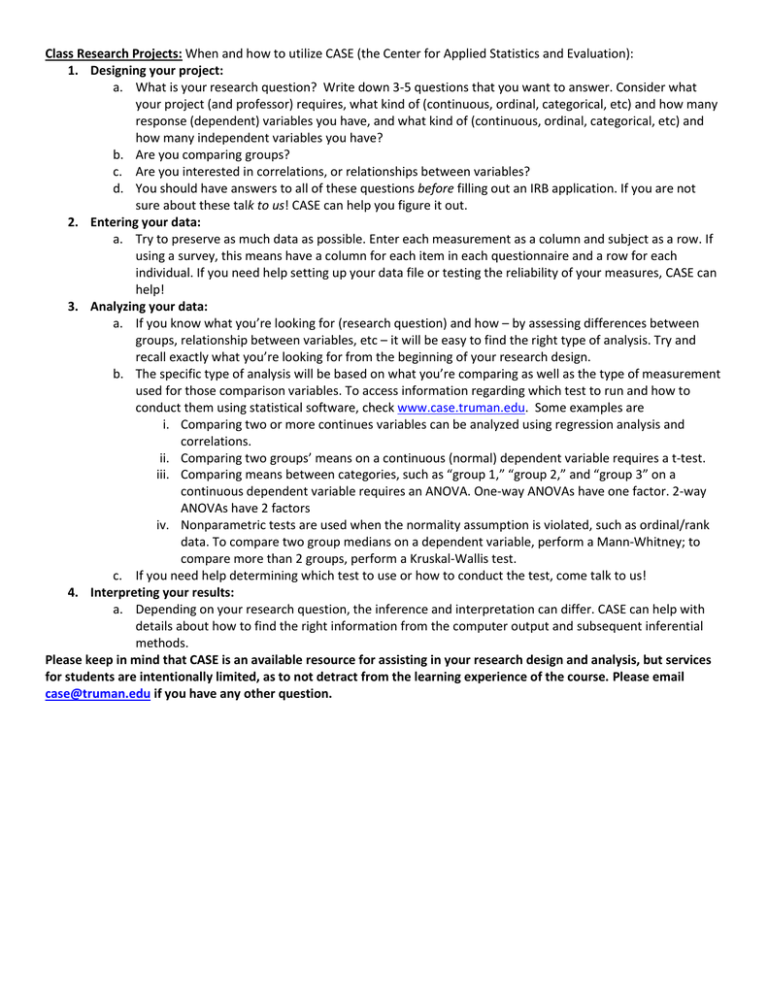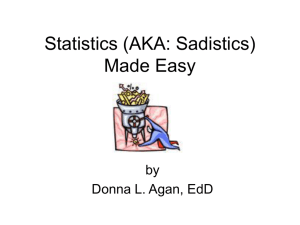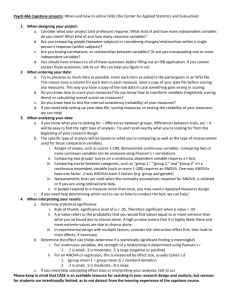Class Research Projects: 1. Designing your project:
advertisement

Class Research Projects: When and how to utilize CASE (the Center for Applied Statistics and Evaluation): 1. Designing your project: a. What is your research question? Write down 3-5 questions that you want to answer. Consider what your project (and professor) requires, what kind of (continuous, ordinal, categorical, etc) and how many response (dependent) variables you have, and what kind of (continuous, ordinal, categorical, etc) and how many independent variables you have? b. Are you comparing groups? c. Are you interested in correlations, or relationships between variables? d. You should have answers to all of these questions before filling out an IRB application. If you are not sure about these talk to us! CASE can help you figure it out. 2. Entering your data: a. Try to preserve as much data as possible. Enter each measurement as a column and subject as a row. If using a survey, this means have a column for each item in each questionnaire and a row for each individual. If you need help setting up your data file or testing the reliability of your measures, CASE can help! 3. Analyzing your data: a. If you know what you’re looking for (research question) and how – by assessing differences between groups, relationship between variables, etc – it will be easy to find the right type of analysis. Try and recall exactly what you’re looking for from the beginning of your research design. b. The specific type of analysis will be based on what you’re comparing as well as the type of measurement used for those comparison variables. To access information regarding which test to run and how to conduct them using statistical software, check www.case.truman.edu. Some examples are i. Comparing two or more continues variables can be analyzed using regression analysis and correlations. ii. Comparing two groups’ means on a continuous (normal) dependent variable requires a t-test. iii. Comparing means between categories, such as “group 1,” “group 2,” and “group 3” on a continuous dependent variable requires an ANOVA. One-way ANOVAs have one factor. 2-way ANOVAs have 2 factors iv. Nonparametric tests are used when the normality assumption is violated, such as ordinal/rank data. To compare two group medians on a dependent variable, perform a Mann-Whitney; to compare more than 2 groups, perform a Kruskal-Wallis test. c. If you need help determining which test to use or how to conduct the test, come talk to us! 4. Interpreting your results: a. Depending on your research question, the inference and interpretation can differ. CASE can help with details about how to find the right information from the computer output and subsequent inferential methods. Please keep in mind that CASE is an available resource for assisting in your research design and analysis, but services for students are intentionally limited, as to not detract from the learning experience of the course. Please email case@truman.edu if you have any other question.

